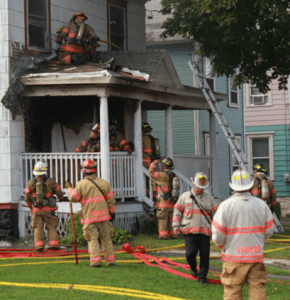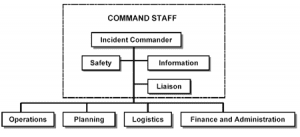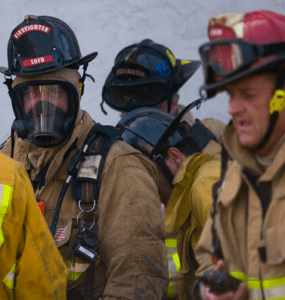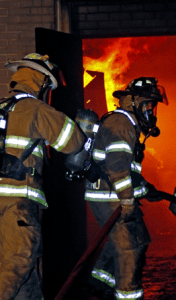 I recently received an email from a firefighter asking for my opinion as to whether or not the administrative chief officers in his department should respond to reported structure fires. My initial response was: “Well, Duh! Yes!”
I recently received an email from a firefighter asking for my opinion as to whether or not the administrative chief officers in his department should respond to reported structure fires. My initial response was: “Well, Duh! Yes!”
But then I got to thinking about it more. How and when administrative chief officers respond to fires may help or may hinder situational awareness and incident safety. That reflection caused me to take pause. The answer isn’t so cut and dried.
So I revised answer is “It depends.” Let me explain why I recanted.
Framing the Problem
 The member with the question is from a combination (“Composite” for my Canadian friends) fire department with 2 career administrative chief officers working during weekday, daytime hours. The department also has several part-time/volunteer operational chief officers who respond predominately during evenings and weekends. There are no chief officers on-duty after normal weekday office hours.
The member with the question is from a combination (“Composite” for my Canadian friends) fire department with 2 career administrative chief officers working during weekday, daytime hours. The department also has several part-time/volunteer operational chief officers who respond predominately during evenings and weekends. There are no chief officers on-duty after normal weekday office hours.
The weekday, daytime response staffing is limited also – both for on-duty personnel and for callback personnel.
The essence of the reader’s inquiry was to garner my opinion as to whether the daytime on-duty administrative chief officers should respond to reported structure fires to provide additional staffing and to support the incident command system.
System Design
 An effective response system should have a pre-established design with certain expectations spelled out in advance for all responders. One of those expectations should be whether or not the administrative chief officers are going to integrate in the response system. If the design is for the administrative chiefs to respond, then the chiefs should respond (when they are able). If the design is for the administrative chiefs not to respond, then the chiefs should not respond (even when they are available).
An effective response system should have a pre-established design with certain expectations spelled out in advance for all responders. One of those expectations should be whether or not the administrative chief officers are going to integrate in the response system. If the design is for the administrative chiefs to respond, then the chiefs should respond (when they are able). If the design is for the administrative chiefs not to respond, then the chiefs should not respond (even when they are available).
The fundamental situational awareness premise for this stance is simple: No surprises. If the chiefs are supposed to respond… then respond. If the chiefs are not supposed to respond… then don’t respond. Being able to develop and maintain situational awareness during structure fires is stressful enough without having curve balls thrown at the responders.
Staffing Levels
 The number of personnel needed for a structure fire should be discussed and established in advance. The number most often shared with me is 15-18 responders. This seems reasonable when you consider the number of tasks that need to be performed concurrently at a structure fire (e.g., command, safety, ops, attack, back-up, search, vent, RIT, water supply, utilities). Where staffing levels are limited, administrative chief officers can become an integral component of the emergency response and incident management.
The number of personnel needed for a structure fire should be discussed and established in advance. The number most often shared with me is 15-18 responders. This seems reasonable when you consider the number of tasks that need to be performed concurrently at a structure fire (e.g., command, safety, ops, attack, back-up, search, vent, RIT, water supply, utilities). Where staffing levels are limited, administrative chief officers can become an integral component of the emergency response and incident management.
Competency of the Administrative Chiefs
 If the administrative chief officers are not competent incident commanders, their response may hinder the operations and adversely impact situational awareness of personnel operating at the emergency scene. When the member who contacted me lamented about his administrative chiefs not responding to structure fires, I thought to myself… “Be careful what you wish for.” If administrative chiefs are well-trained and competent incident managers they can be a tremendous asset during a structure fire. If they aren’t well-trained and incompetent, they can be a tremendous liability.
If the administrative chief officers are not competent incident commanders, their response may hinder the operations and adversely impact situational awareness of personnel operating at the emergency scene. When the member who contacted me lamented about his administrative chiefs not responding to structure fires, I thought to myself… “Be careful what you wish for.” If administrative chiefs are well-trained and competent incident managers they can be a tremendous asset during a structure fire. If they aren’t well-trained and incompetent, they can be a tremendous liability.
Integration into Training
 If administrative chief officers are going to respond to structure fires they need to participate in training evolutions with the front-line responders. It is a well-established best practice that front-line operational personnel practice structural firefighting skills on a regular basis. Among the many benefits of practicing skills is improved communications and incident coordination. If the administrative chiefs do not regularly participate in the training, there is a risk they will be a liability because their communications skills and coordination skills may be under-developed.
If administrative chief officers are going to respond to structure fires they need to participate in training evolutions with the front-line responders. It is a well-established best practice that front-line operational personnel practice structural firefighting skills on a regular basis. Among the many benefits of practicing skills is improved communications and incident coordination. If the administrative chiefs do not regularly participate in the training, there is a risk they will be a liability because their communications skills and coordination skills may be under-developed.
Equally as bad, when administrative chiefs do not participate in the training sessions they may not understand the abilities (and inabilities) of the front-line personnel they will be supervising. This can adversely impact situational awareness. The highest level of situational awareness comes from being able to accurately predict future events.
When administrative chiefs are unfamiliar with crew abilities they cannot effectively predict the performance of the crews. Thus, they cannot accurately predict the future outcomes of that performance and Level 3 Situational Awareness is flawed.
Chief Gasaway’s Advice
 1. Establish, in advance, the qualifications for command positions and ensure those who are going to command incidents are competent. This may include, or exclude, administrative chief officers.
1. Establish, in advance, the qualifications for command positions and ensure those who are going to command incidents are competent. This may include, or exclude, administrative chief officers.
2. Set and communicate expectations, in advance, for what types of calls the administrative chief officers will respond to and what role they will play when they arrive.
3. If the administrative chief’s officers are going to be active responders, integrate them into operational training evolutions so they get to know the capabilities of personnel and they get to practice their roles in advance of emergency responses.
Discussion Questions
 1. Discuss the qualifications for competent commanders. Evaluate all potential commanders to determine if they meet the qualifications. Help those whose training or skills are deficient in achieving the minimums.
1. Discuss the qualifications for competent commanders. Evaluate all potential commanders to determine if they meet the qualifications. Help those whose training or skills are deficient in achieving the minimums.
2. Discuss, in advance of an incident, the types of incidents administrative chief officers will respond to and what role they will play at the incident scene when they do respond.
3. Discuss how to integrate administrative chief officer participation into company level training to ensure the chiefs understand the abilities (and inabilities) of personnel and they are skilled at incident communications and coordination.
_____________________________________________________
If you are interested in taking your understanding of situational awareness and high-risk decision making to a higher level, check out the Situational Awareness Matters Online Academy.
CLICK HERE for details, enrollment options and pricing.
__________________________________
Share your comments on this article in the “Leave a Reply” box below. If you want to send me incident pictures, videos or have an idea you’d like me to research and write about, contact me. I really enjoy getting feedback and supportive messages from fellow first responders. It gives me the energy to work harder for you.
Thanks,
Email: Support@RichGasaway.com
Phone: 612-548-4424
Facebook Fan Page: www.facebook.com/SAMatters
Twitter: @SAMatters
LinkedIn: Rich Gasaway
YouTube: SAMattersTV
iTunes: SAMatters Radio



I while heartedly agree. Admin Chief Officers should respond kid they are integrated into the system and are prepared to do so. They may offer different perspectives and have the ability to access resources that may be over-looked by the I initial “operational” chief. Interference for ego sake is, as we know, counter productive. During complex or extended operational periods, administrative chiefs should be considered essential.
Dennis,
The issue that gave rise to the article wasn’t well-trained, well-prepared knowledgeable administrative chiefs responding and serving vital roles in the incident command system. It was written from three foundations:
1. Under prepared, poorly trained, ego-driven administrative chiefs responding, sticking their authority in where it doesn’t belong and messing things up. I’m all for chiefs responding, of any rank, when their contributions improve safety.
2. Administrative chiefs that should be responding… don’t. For whatever reason.
3. Administrative chiefs who know they are not prepared to be in command support roles but are ordered to respond and assume such roles when they were never prepared for those duties.
Thanks for sharing.
Rich
Nearly every one of these I read has some application in my “day job” which is sitting at a desk and monitoring and fixing a large wide area network. It comes back to the you play the way you train. I don’t remember if you have shared the police officer giving the gun back to the convenience store robbery but that one has to be the best explanation of that I have heard. I hope you don;t mind that i have used it in several settings as well as other wisdom you pass along. Often I am sure we know it, we just need to be reminded and have it burned in.
I dislike having someone on a problem conference call who is administrative and has no real technical experience because they delay the fix. Sure this is a small impact compared to a life or injury but the principle is the same. I am SAR and now Fire Police so I don’t go into burning buildings. But there are risks in those and someone breaking the situation awareness can get someone killed. I can only imagine how much more that is the case on an active fire ground.
Thanks Chief… I hope others are reading and maybe passing a little of this along.
Ralph,
Thanks for taking time to post a comment. I appreciate it very much. Oh yes, they’re reading. Over 2 MILLION page views in the first year the site was operational. That humbles me so much.
Rich
Good Morning Rich,
Great article, I couln’t agree more.
Aside from those administrative chiefs that shouldn’t be responding, I wonder how many departments have those firefighters that are in the same category?
We, as efffective leaders, need to manage those people into a position where they are well trained and valuable on scene or out of the organization.
Dave,
I agree completely. There is little margin for error on the scenes of critical calls.
Rich
Evening Doc:
Enjoyed the article and one of the things we are working on is the assignments based on arrival. First Chief, of course is IC. Second takes a tactical position opposite of IC location, thus giving the IC, eyes where they don’t have them. The next Chief has a couple of options as the IC see’s fit. Either running more in depth accountability, or an operational position-division/group or as an advisor inside Command Car.
The more intricate the campaign then we move to more tactical accountability and divisional supervision. Any thoughts on order to fill positions based on arrival is always appreciated.
Thanks for continued committment to helping us SURVIVE
LANCE
Lance,
Sending three chiefs to a structure fire is light years beyond what many departments do. Your logic for the assignments is sound – I’d even go as far as to say it’s a best practice. I am completely confident you see the direct safety benefit from utilizing chiefs this way. And, whether they say it or not, I am also confident your firefighters appreciate the attention to their safety.
Thanks for sharing!
Rich
Hi Rich,
Thank you for writing about an important issue in our industry. The old days of “hiding the sick, lame and the lazy” on days must be rooted out. Since response is what our customers care the most about and our operational folks use it as a litmus test for value in the organization, it is imperative from a leadership perspective that all chief officers stay engaged in operational response. This means more work for some than others, but it must be done. In Washington state, except for the Fire Chief, a day shift member must participate in response operations or they are not eligible for the Law Enforcement Officers and Firefighters Pension system which is a huge hit in benefits. Thanks again for your insight and helping us continuously improve!